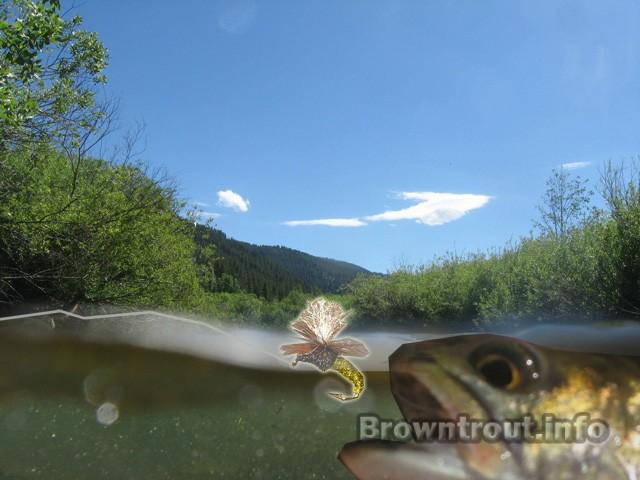This post was last updated on January 9th, 2014 at 04:45 pm
Emerger Flies and Patterns
 Have you ever been on the river when the trout were feeding heavily, yet you could’t see exactly what the fish are feeding on. They are definitely eating something, but there are no visible insects on the water. Chances are those fish are eating emerger flies: The hatching insects that are just below the surface film of the water. Trout love to eat these easy mayfly, Stonefly and caddis meals.
Have you ever been on the river when the trout were feeding heavily, yet you could’t see exactly what the fish are feeding on. They are definitely eating something, but there are no visible insects on the water. Chances are those fish are eating emerger flies: The hatching insects that are just below the surface film of the water. Trout love to eat these easy mayfly, Stonefly and caddis meals.
It can become frustrating to the fly fisherman on the trout stream, when there are large brown trout eating all over the place; and they won’t touch your dry flies that are floating right over their heads time after time. Its always a good idea to have some emerger flies in your boxes just in case the picky trout won’t touch the dry fly or the nymphs that are typically used by most fly fishing enthusiasts.
What is an Emerger fly Pattern?
An emerger is when the nymphs, or larval stage of the insects are floating to the surface of the river to shed their casing and become adult flies. They will “emerge” from the shell of the nymph and for a small time will float near the surface trying to remove their wings and body from the casing before flying off as an adult mayfly or caddis.
How to Identify Trout Eating Emerger Flies
If you learn to identify the trout eating the emerger fly patterns, you will be well on your way to landing the huge trout that are possible feeding heavily in front of you on seemingly everything except for your offering of flies.
Fish are probably eating emerger patterns if you witness..
- If trout are visibly coming up near the surface and flashing and making small boils.
- If there is heavy feeding activity, yet there are no visible flies on the surface of the water
- You can see some flies in the air, but no duns or spinners sitting on the surface
Types of Emerger Flies
You can tie many types of emerger patterns: Some have foam on the top to provide you a nice easy way to locate your flies during your drift, while other emerger flies use poly yarn and even calf tail for the floating upper portion of the fly pattern. The poly wing seems to be the easiest for me to see, unless the foam upper of the emerger pattern is tied with pink or bright yellow/orange foam. It can often be difficult to differentiate the white poly or foam, from the nearby bubbles on the surface of the water.
Using emerger flies is a great tactic to help you land more trout on your next fly fishing trip, so be sure to include at least a few emerger patterns in your box!
